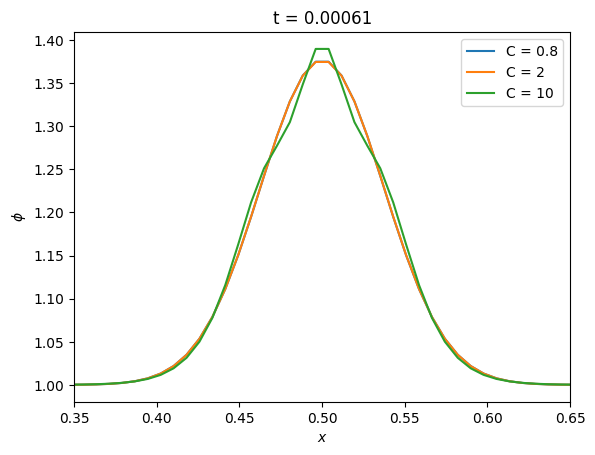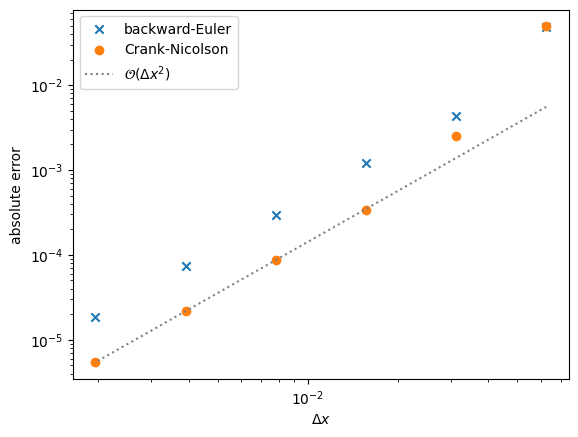Homework 7 solutions#
We want to solve the diffusion equation using implicit Crank-Nicolson time integration.
We can reuse the backward-difference implicit solver from class, and we just need to change a few things.
import numpy as np
import matplotlib.pyplot as plt
The grid class is unchanged.
class Grid:
""" a simple class to hold cell-centered finite-difference /
finite-volume data """
def __init__(self, nx, ng, xmin=0.0, xmax=1.0):
self.xmin = xmin
self.xmax = xmax
self.ng = ng
self.nx = nx
# python is zero-based. Make easy integers to know where the
# real data lives
self.ilo = ng
self.ihi = ng+nx-1
# physical coords -- cell-centered
self.dx = (xmax - xmin)/(nx)
self.x = xmin + (np.arange(nx+2*ng)-ng+0.5)*self.dx
# storage for the solution
self.phi = np.zeros((nx+2*ng), dtype=np.float64)
def scratch_array(self):
""" return a scratch array dimensioned for our grid """
return np.zeros((self.nx+2*self.ng), dtype=np.float64)
def fill_BCs(self):
""" fill the ghostcells with zero gradient (Neumann)
boundary conditions """
self.phi[0:self.ilo] = self.phi[self.ilo]
self.phi[self.ihi+1:] = self.phi[self.ihi]
def norm(self, e):
""" return the norm of quantity e which lives on the grid """
if not len(e) == (2*self.ng + self.nx):
return None
return np.sqrt(self.dx*np.sum(e[self.ilo:self.ihi+1]**2))
We’ll use the same test problem as before: a Gaussian profile.
def gaussian_ic(g, k, t=0.0, t0=1.e-4, phi1=1.0, phi2=2.0):
xc = 0.5*(g.xmin + g.xmax)
return (phi2 - phi1) * (np.sqrt(t0/(t + t0)) *
np.exp(-0.25 * (g.x - xc)**2 / (k * (t + t0)))) + phi1
from scipy import linalg
To allow for comparison, here’s the first-order backward-Euler method
def implicit_step_be(gr, phi, k, dt):
""" diffuse phi implicitly through timestep dt using backward-Euler"""
phinew = gr.scratch_array()
alpha = k * dt / gr.dx**2
# create the RHS of the matrix
R = phi[gr.ilo:gr.ihi+1]
# create the diagonal, d+1 and d-1 parts of the matrix
d = (1.0 + 2.0*alpha)*np.ones(gr.nx)
u = -alpha*np.ones(gr.nx)
u[0] = 0.0
l = -alpha*np.ones(gr.nx)
l[-1] = 0.0
# set the boundary conditions by changing the matrix elements
# homogeneous neumann
d[0] = 1.0 + alpha
d[-1] = 1.0 + alpha
# solve
A = np.matrix([u, d, l])
phinew[gr.ilo:gr.ihi+1] = linalg.solve_banded((1, 1), A, R)
return phinew
and here’s the Crank-Nicolson method. The changes from backward-Euler are:
the righthand side array,
R, now has the explicit diffusion term addedthe matrix elements
d,u, andlare all changed
def implicit_step_cn(gr, phi, k, dt):
""" diffuse phi implicitly through timestep dt """
phinew = gr.scratch_array()
alpha = k * dt / gr.dx**2
# create the RHS of the matrix
gr.fill_BCs()
R = phi[gr.ilo:gr.ihi+1] + 0.5 * alpha * (phi[gr.ilo+1:gr.ihi+2] - 2.0 * phi[gr.ilo:gr.ihi+1] + phi[gr.ilo-1:gr.ihi])
# create the diagonal, d+1 and d-1 parts of the matrix
d = (1.0 + alpha)*np.ones(gr.nx)
u = -0.5 * alpha * np.ones(gr.nx)
u[0] = 0.0
l = -0.5 * alpha * np.ones(gr.nx)
l[-1] = 0.0
# set the boundary conditions by changing the matrix elements
# homogeneous neumann
d[0] = 1.0 + 0.5 * alpha
d[-1] = 1.0 + 0.5 * alpha
# solve
A = np.matrix([u, d, l])
phinew[gr.ilo:gr.ihi+1] = linalg.solve_banded((1, 1), A, R)
return phinew
Here’s the main loop. The main difference now, compared to what we did previously is that our grid has 1 ghostcell (instead of 0) and we will the boundary conditions ever step. This is needed because we need to compute the second-derivative term as part of the righthand side that enters the matrix solve.
def diffuse_implicit(nx, k, C, tmax, init_cond, method="CN"):
"""
the main evolution loop. Evolve
phi_t = k phi_{xx}
from t = 0 to tmax
"""
# create the grid
ng = 1
g = Grid(nx, ng)
# time info
dt = C * 0.5 *g.dx**2 / k
t = 0.0
# initialize the data
g.phi[:] = init_cond(g, k)
while t < tmax:
g.fill_BCs()
# make sure we end right at tmax
if t + dt > tmax:
dt = tmax - t
# diffuse for dt
if method == "CN":
phinew = implicit_step_cn(g, g.phi, k, dt)
elif method == "BE":
phinew = implicit_step_be(g, g.phi, k, dt)
else:
raise ValueError(f"unknown method: {method}")
g.phi[:] = phinew[:]
t += dt
return g
Let’s estimate the diffusion time across a single cell
nx = 128
k = 1
t_diffuse = (1.0/nx)**2 / k
Now let’s see how the new method does with different timesteps
fig, ax = plt.subplots()
tmax = 10 * t_diffuse
for C in [0.8, 2, 10]:
g = diffuse_implicit(nx, k, C, tmax, gaussian_ic, method="CN")
ax.plot(g.x[g.ilo:g.ihi+1], g.phi[g.ilo:g.ihi+1], label=f"C = {C}")
ax.set_xlim(0.35, 0.65)
ax.set_xlabel("$x$")
ax.set_ylabel("$\phi$")
ax.set_title(f"t = {tmax:7.3g}")
ax.legend()
<matplotlib.legend.Legend at 0x7f95bf2d7ee0>

Finally, let’s compare the convergence of the original backward-Euler and the new Crank-Nicolson methods
nx_reference = 64
t_diffuse = (1.0/nx_reference)**2 / k
fig, ax = plt.subplots()
Ns = [16, 32, 64, 128, 256, 512]
dxs = []
be_errors = []
cn_errors = []
tmax = 10 * t_diffuse
C = 0.8
for nx in Ns:
g_be = diffuse_implicit(nx, k, C, tmax, gaussian_ic, method="BE")
g_cn = diffuse_implicit(nx, k, C, tmax, gaussian_ic, method="CN")
phi_analytic = gaussian_ic(g_be, k, t=tmax)
dxs.append(g_be.dx)
be_errors.append(g_be.norm(g_be.phi - phi_analytic))
cn_errors.append(g_cn.norm(g_cn.phi - phi_analytic))
ax.scatter(dxs, be_errors, marker="x", label="backward-Euler")
ax.scatter(dxs, cn_errors, marker="o", label="Crank-Nicolson")
ideal = cn_errors[-1] * np.array(dxs)**2 / dxs[-1]**2
ax.plot(dxs, ideal, color="0.5", ls=":", label=r"$\mathcal{O}(\Delta x^2)$")
ax.legend()
ax.set_xscale("log")
ax.set_yscale("log")
ax.set_xlabel(r"$\Delta x$")
ax.set_ylabel("absolute error")
Text(0, 0.5, 'absolute error')

We see that the Crank-Nicolson method is more accurate, but both converge 2nd-order overall.


